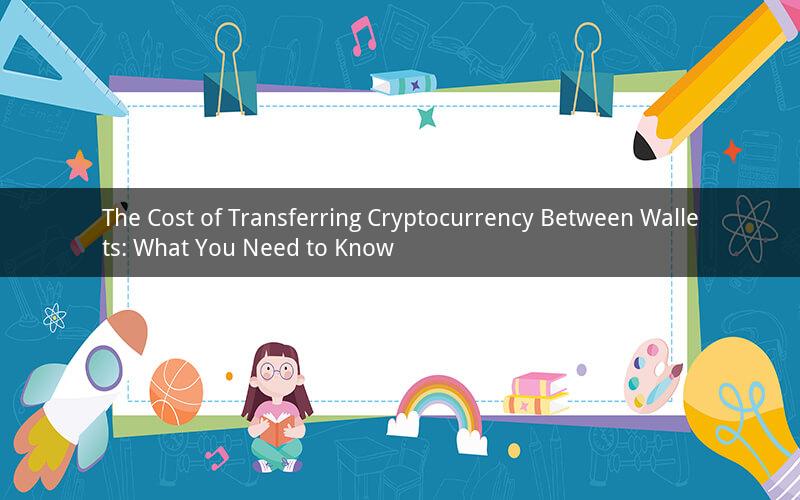
Cryptocurrency wallets have become an integral part of the crypto ecosystem, allowing users to store, manage, and transfer digital assets. However, transferring cryptocurrencies between wallets can sometimes come with a price. In this article, we will delve into the factors that contribute to the cost of transferring crypto between wallets, explore the various methods available, and provide you with the necessary information to make an informed decision.
I. Understanding the Cost of Transferring Crypto
The cost of transferring cryptocurrency between wallets can vary significantly based on several factors. Before we explore these factors, let's define what we mean by "cost." When transferring crypto between wallets, the term "cost" refers to the network fees, also known as transaction fees or gas fees, that need to be paid to miners or validators for processing the transaction.
A. Network Fees
Network fees are determined by the blockchain network on which the cryptocurrency operates. For instance, Bitcoin's network fees are higher than those of Ethereum due to its higher demand and limited block space. The cost of these fees is influenced by the following factors:
1. Blockchain Network: The cost of network fees varies across different blockchain networks. Some networks have lower fees due to their efficient design or limited popularity, while others have higher fees due to their high demand and popularity.
2. Transaction Size: The size of the transaction impacts the network fees. Larger transactions require more space on the blockchain, resulting in higher fees.
3. Network Congestion: During periods of high network congestion, the fees tend to rise as miners prioritize transactions with higher fees.
B. Transaction Speed
The cost of transferring crypto between wallets can also be influenced by the desired transaction speed. Generally, faster transactions incur higher fees. Users have the option to choose from various transaction speeds, such as:
1. Instant: Some wallets offer instant transactions, but they may come with higher fees.
2. Standard: This is the default transaction speed and usually incurs lower fees. However, it can take longer to complete.
3. Fast: This option provides faster transaction speeds at a higher cost.
II. Methods for Transferring Crypto Between Wallets
Now that we understand the factors that contribute to the cost of transferring crypto between wallets, let's explore the various methods available:
A. Direct Wallet-to-Wallet Transfer
The most straightforward method for transferring crypto between wallets is a direct wallet-to-wallet transfer. This method involves generating a unique address for the recipient's wallet and entering it into the sender's wallet to initiate the transfer. This method is suitable for transferring small amounts with lower fees and is widely used among crypto users.
B. Exchange Platforms
Many users opt for cryptocurrency exchanges to transfer funds between wallets. Exchanges provide a secure platform to buy, sell, and transfer cryptocurrencies. When using an exchange for transferring crypto between wallets, the process involves the following steps:
1. Log in to your exchange account.
2. Navigate to the transfer or withdraw section.
3. Select the cryptocurrency you wish to transfer.
4. Enter the recipient's wallet address.
5. Specify the amount to transfer.
6. Confirm the transaction and pay the required network fees.
C. Crypto Custody Services
Crypto custody services are another option for transferring crypto between wallets. These services provide secure storage and management of digital assets. Users can transfer funds to their crypto custody service, and the service will handle the transfer to the recipient's wallet.
III. Conclusion
Transferring crypto between wallets can be a cost-effective process when you understand the factors that influence the network fees. By considering the blockchain network, transaction size, network congestion, and desired transaction speed, you can make informed decisions regarding the cost of transferring cryptocurrencies between wallets.
Now, let's address some common questions related to the cost of transferring crypto between wallets:
1. How can I lower the cost of transferring crypto between wallets?
You can lower the cost of transferring crypto by choosing a less congested blockchain network, reducing the transaction size, and selecting a standard transaction speed.
2. Are network fees the only costs associated with transferring crypto between wallets?
Yes, network fees are the primary costs associated with transferring crypto between wallets. However, you may also encounter additional fees for using certain wallet services or crypto custody services.
3. Can I transfer crypto between wallets for free?
It is rare to transfer crypto between wallets for free, as network fees are an integral part of the blockchain process. However, some wallet providers may offer promotions or discounts on network fees.
4. Are there any risks involved in transferring crypto between wallets?
Yes, there are risks involved in transferring crypto between wallets. These include the potential for losing funds due to incorrect wallet addresses, hacking, or technical failures.
5. Can I cancel a pending crypto transfer?
Once a transaction is initiated, it is generally not possible to cancel it. However, you may be able to reverse the transaction if the recipient's wallet is on a blockchain that supports such functionality, such as Bitcoin.
By understanding the cost of transferring crypto between wallets and the methods available, you can ensure a smooth and secure transaction process.